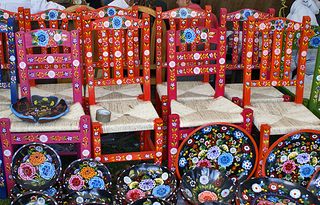
Painted children's chairs from Quiroga, Michoacán. All photographs by Mexico Cooks! unless otherwise noted.
Today's Mexico Cooks! article celebrates the artisans, ancient traditions, and glorious representation of the state of Michoacán. It also celebrates the recent publication of Artisans of Michoacán: By Their Hands, my friend Travis Whitehead's several-year-long project of interviews and photographs of Michoacán's artisans at work. Rather than express my thoughts about Travis's passion and dedication to his work, Mexico Cooks! prefers to let him tell his own story. He generously allows me to publish the text of the speech he gave earlier this year in Morelia, Michoacán. I give you Travis Whitehead:
_____________________________________________________________
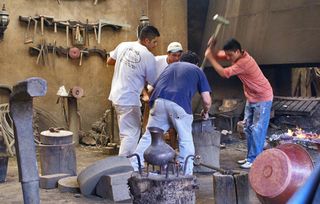
Working copper, Santa Clara del Cobre, Michoacán.
Forty-five years ago, I saw something that grabbed my attention and never let go: a caterpiller evolving into an elegant monarch butterfly. Witnessing this display of metamorphosis would leave a lasting impression on me, one that would eventually lead me on an odyssey of change, of release, and of the discovery of identity.
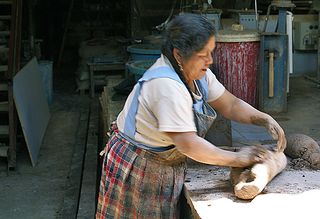
Rolling hand-ground clay for high-fired ceramics in Patamban, Michoacán.
The journey toward that odyssey began the day my mother showed me how to remove a monarch caterpillar from the milkweed plant outside my Texas house, place it in a jar with plenty of leaves, and watch it grow. Soon it would wrap itself into a green chrysalis, and I would wait anxiously for it to emerge into an entirely different form of life. My curiosity was forever ignited by this process of change, and I kept a close eye on the milkweed plants so I could capture more caterpillers and observe this process again.

Hand-painted batea (wooden tray), state of Michoacán.
When the butterflies finally emerged, I would take them outside and watch as they flew into the blue sky. I didn't know then what we all know now: they were headed for Michoacán. I wonder if perhaps the butterflies I released took a part of me with them, bringing a trace of myself into an enchanting place. I wonder if perhaps that part of my soul born on the wings of the monarchs hibernated, even gestated, in the magical wonderland of Michoacán, awaiting my arrival when I would regain part of myself, taking full possession of my poetic voice.
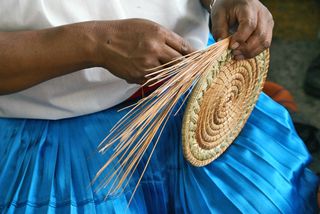
Weaving a huinumo (pine needle) hot pad, Paracho, Michoacán.
I found the place I'd been seeking my whole life quite by accident, stumbling across it while working on another project. That project failed to materialize, but by then I had become intoxicated by the state's metamorphic personality. That metamorphosis was everywhere, in the food, the language of the Purépecha indians, the crafts, and even the very landscape. The state, I learned, even has two local varieties of the tamal–the corunda and the uchepo–and I discovered that in the Meseta Purépecha, even these and other regional recipes vary from one village to the next, and that the language has slight changes in communities only a short distance from each other: a metamorphosis taking place in food and words. The very landscape itself is a metamorphic experience, ranging from pine-covered hills to stark deserts, from winding rocky shoreline to tropical jungles.
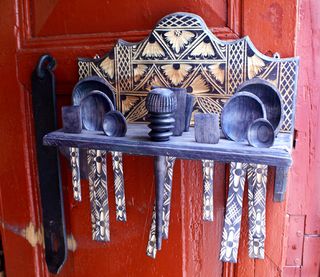
Spoon rack on red door, Pátzcuaro, Michoacán.
So strong was Michoacán's power over me that I felt compelled to spend an extended amount of time with her, so I moved there in 2008 and spent eight months visiting artisans in their homes and workshops. I was quickly charmed by the way they welcomed me into their lives. I was a stranger who came knocking on their doors, and they quickly extended their friendship to me. They allowed me to observe them practicing their crafts and take as many pictures as I wanted. They patiently answered my endless questions. I was intrigued to discover that even their crafts were continuously evolving into innovative forms, revealing still another experience of metamorphosis. With every Michoacán experience, my artistic life constantly split and then coalesced into an ever-evolving consciousness. It was a revolving kaleidoscopic experience of dissonance and resolution, crescendo and diminuendo, soaring to enormous heights and then crashing miserably so that I would have to hibernate for a while until my previous perspective acquiesced to the new insights I had achieved.
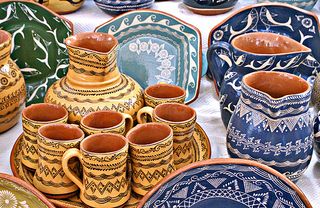
Several types of hand-made, hand-painted clay tableware, Capula, Michoacán.
However, as my poetic voice matured, so did my perspective about culture. Initially, my experiences with the artisans were conduits through which I could communicate my ever-changing poetic voice. The artisans, though, offered me genuine friendship and even a chance to participate in their daily lives. I sat with them around their hearth fires; they shared their meals with me. I took them to a cornfield so they could pick loads of corn; then I helped shuck that corn to make uchepos. I watched with delight as their children laughed and played together, sneaking up behind me with their toy pistols–BOOM! BOOM! BOOM!–before giggling and running away. I participated in one of their festivals, and soon 'my' project became less about me and more about giving them a voice to the rest of the world, sharing the story behind the crafts for which they are so famous.
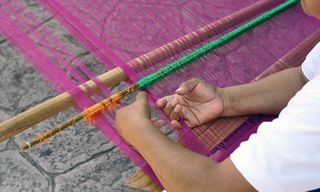
Counting threads while weaving a fine rebozo (shawl) from Aranza, Michoacán.
As I observed the pace of their daily lives and the way they related to one another, I began to wonder if the crafts, the festivals, and dances are really what define a culture. Are those the things that really define culture, or are they merely details? I'm not so sure. Perhaps the real cultural experience is the way a group of people relates to one another and interacts with each other. It's a question I still ask myself.
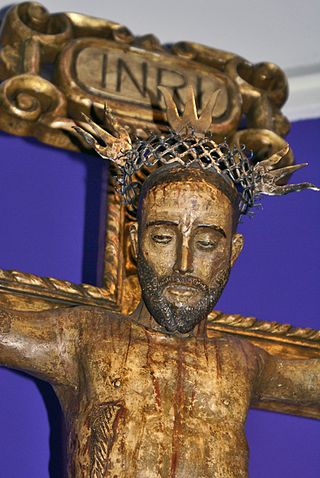
Seventeenth century Michoacán Cristo (Christ) made of pasta de caña.
The crafts and artisans and the metamorphic life of Michoacán still have a hold on me. But I think that Michoacán has taught me a much greater lesson: the value of life and the way people experience that life, and the warmth and friendship people extend toward one another–and even to strangers who come knocking on their doors. This was truly the greatest of my metamorphic experiences in Michoacán.
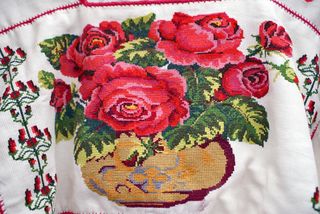
Hand cross-stitched guayanga (blouse), Pichátaro, Michoacán.
____________________________________________________________
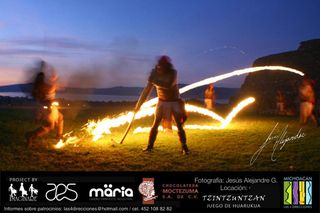
Juego de Huarukua (ancient Purépecha fireball game), Tzintzuntzan, Michoacán. Photo courtesy Jesús Alejandre G., Uruapan.
On June 27, 2013, Travis Whitehead will present Artisans of Michoacán: By Their Hands at Pátzcuaro's Museo Regional de Artes Populares, in conjunction with an important exhibit of new photographs of Michoacán by Uruapan native Jesús Alejandre. The opening of photographer Alejandre's exhibition and the presentation of Whitehead's book will be June 27, 2013 at 5:00PM.
Looking for a tailored-to-your-interests specialized tour in Mexico? Click here: Tours.
Leave a Reply